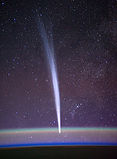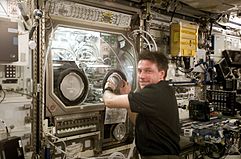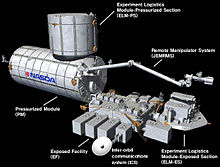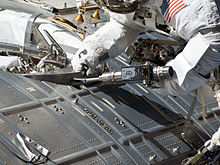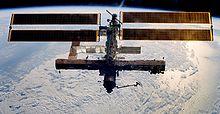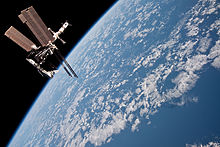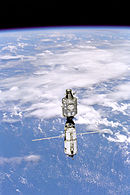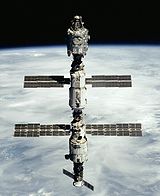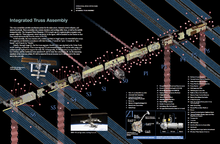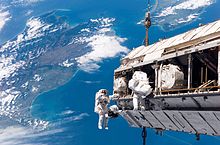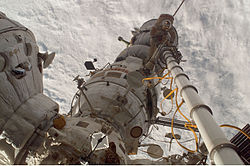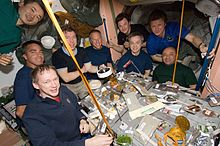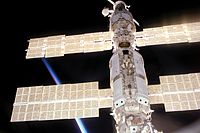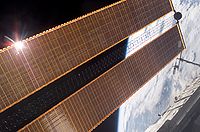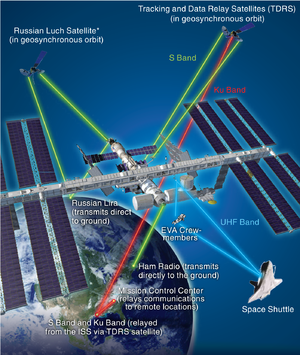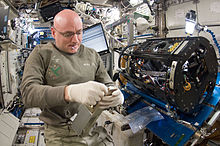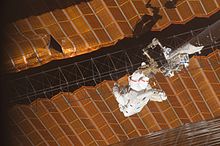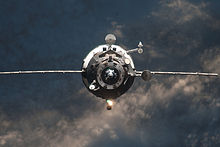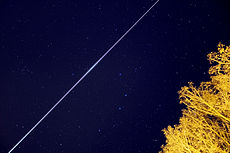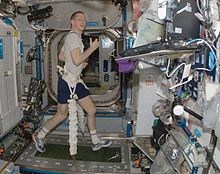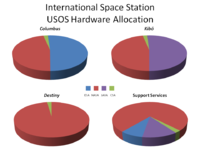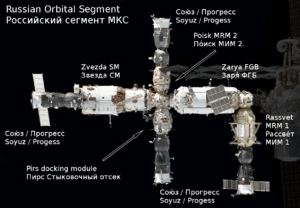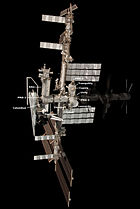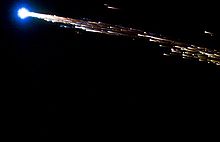
International Space Station
Background to the schools Wikipedia
This selection is made for schools by a children's charity read more. Sponsoring children helps children in the developing world to learn too.
 |
||
| The International Space Station, as seen from Space Shuttle Endeavour in May 2011. | ||
 |
||
| ISS insignia | ||
| Station statistics | ||
|---|---|---|
| COSPAR ID | 1998-067A | |
| Call sign | Alpha | |
| Crew | Fully crewed 6 Currently onboard 6 ( Expedition 35) |
|
| Launch | 1998–2020 | |
| Launch pad | Baikonur LC-81/23, LC-1/5 KSC LC-39, |
|
| Mass | approximately 450,000 kg (990,000 lb) | |
| Length | 72.8 m | |
| Width | 108.5 m | |
| Height | c. 20 m (c. 66 ft) nadir–zenith, arrays forward–aft (27 November 2009) |
|
| Pressurised volume | 837 m3 (29,600 cu ft) (21 March 2011) |
|
| Atmospheric pressure | 101.3 kPa (29.91 inHg, 1 atm) | |
| Perigee | 402 km (250 mi) AMSL (02 November 2012 04:38:51 epoch) |
|
| Apogee | 424 km (263 mi) AMSL (02 November 2012 04:38:51 epoch) |
|
| Orbital inclination | 51.6 degrees | |
| Average speed | 7,706.6 m/s (27,743.8 km/h, 17,239.2 mph) |
|
| Orbital period | 92 minutes 50 seconds (02 November 2012 04:38:51 epoch) |
|
| Days in orbit | 5253 (8 April) |
|
| Days occupied | 4540 (8 April) |
|
| Number of orbits | 82454 (8 April) |
|
| Orbital decay | 2 km/month | |
| Statistics as of 9 March 2011 (unless noted otherwise) |
||
| References: | ||
| Configuration | ||
 |
||
| Station elements as of December 2011, but missing Pirs ( exploded view) |
||
The International Space Station (ISS) is a habitable artificial satellite in low Earth orbit. It follows the Salyut, Almaz, Skylab and Mir stations as the ninth space station to be inhabited. The ISS is a modular structure whose first component was launched in 1998. Now the largest artificial body in orbit, it can often be seen at the appropriate time with the naked eye from Earth. The ISS consists of pressurised modules, external trusses, solar arrays and other components. ISS components have been launched by American Space Shuttles as well as Russian Proton and Soyuz rockets. Budget constraints led to the merger of three space station projects with the Japanese Kibō module and Canadian robotics. In 1993 the partially built components for a Soviet/Russian space station Mir-2, the proposed American Freedom, and the proposed European Columbus merged into a single multinational programme.
The ISS serves as a microgravity and space environment research laboratory in which crew members conduct experiments in biology, human biology, physics, astronomy, meteorology and other fields. The station is suited for the testing of spacecraft systems and equipment required for missions to the Moon and Mars.
The station has been continuously occupied for 12 years and 157 days, having exceeded the previous record of almost 10 years (or 3,634 days) held by Mir, in 2010. The station is serviced by Soyuz spacecraft, Progress spacecraft, the Automated Transfer Vehicle, the H-II Transfer Vehicle, and the Dragon spacecraft. It has been visited by astronauts and cosmonauts from 15 different nations.
The ISS programme is a joint project among five participating space agencies: NASA, the Russian Federal Space Agency, JAXA, ESA, and CSA. The ownership and use of the space station is established by intergovernmental treaties and agreements. The station is divided into two sections, the Russian orbital segment (ROS) and the United States orbital segment (USOS), which is shared by many nations. The ISS is maintained at an orbital altitude of between 330 km (205 mi) and 435 km (270 mi). It completes 15.7 orbits per day. The ISS is funded until 2020, and may operate until 2028. The Russian Federal Space Agency (RSA/RKA) has proposed using ISS to commission modules for a new space station, called OPSEK, before the remainder of the ISS is de-orbited.
Purpose
According to the original Memorandum of Understanding between NASA and RSA, the International Space Station was intended to be a laboratory, observatory and factory in space. It was also planned to provide transportation, maintenance, and act as a staging base for possible future missions to the Moon, Mars and asteroids. In the 2010 United States National Space Policy, the ISS was given additional roles of serving commercial, diplomatic and educational purposes.
Scientific research
The ISS provides a platform to conduct scientific research that cannot be performed in any other way. While small unmanned spacecraft can provide platforms for zero gravity and exposure to space, space stations offer a long term environment where studies can be performed potentially for decades, combined with ready access by human researchers over periods that exceed the capabilities of manned spacecraft.
The Station simplifies individual experiments by eliminating the need for separate rocket launches and research staff. The primary fields of research include Astrobiology, astronomy, human research including space medicine and life sciences, physical sciences, materials science, space weather and weather on Earth (meteorology). Scientists on Earth have access to the crew's data and can modify experiments or launch new ones, benefits generally unavailable on unmanned spacecraft. Crews fly expeditions of several months duration, providing approximately 160 man-hours a week of labour with a crew of 6.
Kibō is intended to accelerate Japan's progress in science and technology, gain new knowledge and apply it to such fields as industry and medicine.
In order to detect dark matter and answer other fundamental questions about our universe, engineers and scientists from all over the world built the Alpha Magnetic Spectrometer (AMS), which NASA compares to the Hubble telescope, and says could not be accommodated on a free flying satellite platform due in part to its power requirements and data bandwidth needs. On 3 April 2013, NASA scientists reported that hints of dark matter may have been detected by the Alpha Magnetic Spectrometer. According to the scientists, " The first results from the space-borne Alpha Magnetic Spectrometer confirm an unexplained excess of high-energy positrons in Earth-bound cosmic rays."
The space environment is hostile to life. Unprotected presence in space is characterised by an intense radiation field (consisting primarily of protons and other subatomic charged particles from the solar wind, in addition to cosmic rays), high vacuum, extreme temperatures, and microgravity. Some simple forms of life called extremophiles, including small invertebrates called tardigrades can survive in this environment in an extremely dry state called desiccation.
Medical research improves knowledge about the effects of long-term space exposure on the human body, including muscle atrophy, bone loss, and fluid shift. This data will be used to determine whether lengthy human spaceflight and space colonisation are feasible. As of 2006, data on bone loss and muscular atrophy suggest that there would be a significant risk of fractures and movement problems if astronauts landed on a planet after a lengthy interplanetary cruise, such as the six-month interval required to travel to Mars. Medical studies are conducted aboard the ISS on behalf of the National Space Biomedical Research Institute (NSBRI). Prominent among these is the Advanced Diagnostic Ultrasound in Microgravity study in which astronauts perform ultrasound scans under the guidance of remote experts. The study considers the diagnosis and treatment of medical conditions in space. Usually, there is no physician on board the ISS and diagnosis of medical conditions is a challenge. It is anticipated that remotely guided ultrasound scans will have application on Earth in emergency and rural care situations where access to a trained physician is difficult.
Microgravity

Contrary to popular belief, the earth's gravity is only slightly less at the altitude of the ISS as at the surface. According to the equivalence principle, gravity only seems absent because, like any orbiting object, it is in continuous freefall. This state of perceived weightlessness is not perfect however, being disturbed by five separate effects:
- Drag from the residual atmosphere; when the ISS enters the Earth's shadow, the main solar panels are rotated to minimise this aerodynamic drag, helping reduce orbital decay.
- Vibration from movements of mechanical systems and the crew.
- Actuation of the on-board attitude control moment gyroscopes.
- Thruster firings for altitude or orbital changes.
- Gravity-gradient effects, also known as tidal effects. Items at different locations within the ISS would, if not attached to the station, follow slightly different orbits. Being mechanically interconnected, however, these items experience small forces that keep the station moving as a rigid body.
Researchers are investigating the effect of the station's near-weightless environment on the evolution, development, growth and internal processes of plants and animals. In response to some of this data, NASA wants to investigate microgravity's effects on the growth of three-dimensional, human-like tissues, and the unusual protein crystals that can be formed in space.
The investigation of the physics of fluids in microgravity will allow researchers to model the behaviour of fluids better. Because fluids can be almost completely combined in microgravity, physicists investigate fluids that do not mix well on Earth. In addition, an examination of reactions that are slowed by low gravity and temperatures will give scientists a deeper understanding of superconductivity.
The study of materials science is an important ISS research activity, with the objective of reaping economic benefits through the improvement of techniques used on the ground. Other areas of interest include the effect of the low gravity environment on combustion, through the study of the efficiency of burning and control of emissions and pollutants. These findings may improve current knowledge about energy production, and lead to economic and environmental benefits. Future plans are for the researchers aboard the ISS to examine aerosols, ozone, water vapour, and oxides in Earth's atmosphere, as well as cosmic rays, cosmic dust, antimatter, and dark matter in the universe.
Exploration
The ISS provides a location in the relative safety of Low Earth Orbit to test spacecraft systems that will be required for long-duration missions to the Moon and Mars. This provides experience in operations, maintenance as well as repair and replacement activities on-orbit, which will be essential skills in operating spacecraft farther from Earth, mission risks can be reduced and the capabilities of interplanetary spacecraft advanced. Referring to the MARS-500 experiment, ESA states that "Whereas the ISS is essential for answering questions concerning the possible impact of weightlessness, radiation and other space-specific factors, aspects such as the effect of long-term isolation and confinement can be more appropriately addressed via ground-based simulations". Sergey Krasnov, the head of human space flight programmes for Russia's space agency, Roscosmos, in 2011 suggested a "shorter version" of MARS-500 may be carried out on the ISS.
In 2009, noting the value of the partnership framework itself, Sergey Krasnov wrote, "When compared with partners acting separately, partners developing complementary abilities and resources could give us much more assurance of the success and safety of space exploration. The ISS is helping further advance near-Earth space exploration and realisation of prospective programmes of research and exploration of the Solar system, including the Moon and Mars." A manned mission to Mars, however, may be a multinational effort involving space agencies and countries outside of the current ISS partnership. In 2010 ESA Director-General Jean-Jacques Dordain stated his agency was ready to propose to the other 4 partners that China, India and South Korea be invited to join the ISS partnership. NASA chief Charlie Bolden stated in Feb 2011 "Any mission to Mars is likely to be a global effort". Currently, American legislation prevents NASA co-operation with China on space projects.
Education and cultural outreach
The ISS crew provide opportunities for students on Earth by running student-developed experiments, making educational demonstrations, allowing for student participation in classroom versions of ISS experiments, and directly engaging students using radio, videolink and email. ESA offers a wide range of free teaching materials that can be downloaded for use in classrooms. In one lesson, students can navigate a 3-D model of the interior and exterior of the ISS, and face spontaneous challenges to solve in real time.
JAXA aims both to "Stimulate the curiosity of children, cultivating their spirits, and encouraging their passion to pursue craftsmanship", and to "Heighten the child's awareness of the importance of life and their responsibilities in society." Through a series of education guides, a deeper understanding of the past and near-term future of manned space flight, as well as that of Earth and life, will be learned. In the JAXA Seeds in Space experiments, the mutation effects of spaceflight on plant seeds aboard the ISS is explored. Students grow sunflower seeds which flew on the ISS for about nine months as a start to 'touch the Universe'. In the first phase of Kibō utilisation from 2008 to mid-2010, researchers from more than a dozen Japanese universities conducted experiments in diverse fields.
Cultural activities are another major objective. Tetsuo Tanaka, director of JAXA's Space Environment and Utilization Centre, says "There is something about space that touches even people who are not interested in science."
Amateur Radio on the ISS (ARISS) is a volunteer programme which encourages students worldwide to pursue careers in science, technology, engineering and mathematics through amateur radio communications opportunities with the ISS crew. ARISS is an international working group, consisting of delegations from 9 countries including several countries in Europe as well as Japan, Russia, Canada, and the United States. In areas where radio equipment cannot be used, speakerphones connect students to ground stations which then connect the calls to the station.
First Orbit is a feature-length documentary film about Vostok 1, the first manned space flight around the Earth. By matching the orbit of the International Space Station to that of Vostok 1 as closely as possible, in terms of ground path and time of day, documentary filmmaker Christopher Riley and ESA astronaut Paolo Nespoli were able to film the view that Yuri Gagarin saw on his pioneering orbital space flight. This new footage was cut together with the original Vostok 1 mission audio recordings sourced from the Russian State Archive. Nespoli, during Expedition 26/27, filmed the majority of the footage for this documentary film, and as a result is credited as its director of photography. The film was streamed through the website www.firstorbit.org in a global YouTube premiere in 2011, under a free license.
Origins
The International Space Station programme represents a combination of three national space station projects: the Russian/Soviet Mir-2, NASA's Freedom including the Japanese Kibō laboratory, and the European Columbus space stations. Canadian robotics supplement these projects.
Mir-2 was originally authorised in the February 1976 resolution setting forth plans for development of third generation Soviet space systems; the first module, which would have served the same function as Zarya, was destroyed in a launch mishap.
In the early 1980s, NASA planned to launch a modular space station called Freedom as a counterpart to the Soviet Salyut and Mir space stations. Freedom was never constructed and the remnants of the project became part of the ISS. The Japanese Experiment Module (JEM), or Kibō, was announced in 1985, as part of the Freedom space station in response to a NASA request in 1982.
In Rome in early 1985, science ministers from the European Space Agency (ESA) countries approved the Columbus program, the most ambitious effort in space undertaken by that organisation at the time. The plan spearheaded by Germany and Italy included a module which would be attached to Freedom, and with the capability to evolve into a full-fledged European orbital outpost before the end of the century. The space station was also going to tie the emerging European and Japanese national space programmes closer to the U.S.-led project, thereby preventing those nations from becoming major, independent competitors too.
In September 1993, American Vice-President Al Gore and Russian Prime Minister Viktor Chernomyrdin announced plans for a new space station, which eventually became the International Space Station. They also agreed, in preparation for this new project, that the United States would be involved in the Mir programme, including American Shuttles docking, in the Shuttle-Mir Program.
Mir-2
The Russian Orbital Segment (ROS or RS) is the eleventh Soviet-Russian space station. Mir ("Peace") and the ISS are successors to the Salyut ("Fireworks") and Almaz ("Diamond") stations. The first MIR-2 module was launched in 1986 by an Energia heavy-lift expendable launch system. The launcher worked properly, however the Polyus payload fired its engines to insert itself into orbit whilst in the wrong position due to a programming error, and re-entered the atmosphere. The planned station changed several times, but Zvezda was always the service module, containing the station's critical systems such as life support. The station would have used the Buran spaceplane and Proton rockets to lift new modules into orbit. The spaceframe of Zvezda, also called DOS-8 serial number 128, was completed in February 1985 and major internal equipment was installed by October 1986.
The Polyus module or spacecraft would have served as the FGB, a foundation which provides propulsion and guidance, but it lacks life support. Polyus was a satellite interceptor/destroyer, carrying a 1 megawatt carbon dioxide laser. The module had a length of almost 37 m and a diameter of 4.1 m, weighed nearly 80 t, and included 2 principal sections, the smallest, the functional service block (FGB), and the largest, the aim module.
In 1983, the design was changed and the station would consist of Zvezda, followed by several 90 metric ton modules and a truss structure similar to the current station. The draft was approved by NPO Energia Chief Semenov on 14 December 1987 and announced to the press as 'Mir-2' in January 1988. This station would be visited by the Soviet Buran, but mainly resupplied by Progress-M2 spacecraft. Orbital assembly of the station was expected to begin in 1993. In 1993 with the collapse of the Soviet Union, a redesigned smaller Mir-2 was to be built whilst attached to Mir, just as OPSEK is being assembled whilst attached to the ISS.
Freedom with Kibō
Approved by then-president Ronald Reagan and announced in the 1984 State of the Union Address, "We can follow our dreams to distant stars, living and working in space for peaceful economic and scientific gain", the proposed Freedom changed considerably.
NASA's first cost assessment in 1987 revealed the "Dual Keel" Station would cost $14.5 billion. This caused a political uproar in Congress, and NASA and Reagan Administration officials reached a compromise in March 1987 which allowed the agency to proceed with a cheaper $12.2-billion Phase One Station that could be completed after 10 or 11 Shuttle assembly flights. This design initially omitted the $3.4-billion 'Dual Keel' structure and half of the power generators. The new Space Station configuration was named Freedom by Reagan in June 1988. Originally, Freedom would have carried two 37.5 kW solar arrays. However, Congress quickly insisted on adding two more arrays for scientific users. The Space Station programme was plagued by conflicts during the entire 1984–87 definition phase. In 1987, the Department of Defense (DoD) briefly demanded to have full access to the Station for military research, despite strong objections from NASA and the international partners. Besides the expected furore from the international partners, the DoD position sparked a shouting match between Defense Secretary Caspar Weinberger and powerful members of Congress that extended right up to the final Fiscal 1988 budget authorisation in July 1987. Reagan wanted to invite other NATO countries to participate in the U.S-led project, since the Soviet Union had been launching international crews to their Salyut space stations since 1971. At one point, then-anonymous disgruntled NASA employees calling themselves "Centre for Strategic Space Studies" suggested that instead of building Freedom, NASA should take the back-up Skylab from display in the National Air and Space Museum in Washington and launch that.
An agreement signed in September 1988 allocated 97% of the US lab resources to NASA while the Canadian CSA would receive 3% in return for its contribution to the programme. Europe and Japan would retain 51% of their own laboratory modules. Six Americans and two international astronauts would be permanently based on Space Station Freedom. Several NASA Space Shuttle missions in the 1980s and early 1990s included spacewalks to demonstrate and test space station construction techniques.
The Japanese Experiment Module (JEM), christened Kibō ("hope") in 1999, is Japan's first manned spacecraft. Kibō consists of a pressurised laboratory dedicated to advanced technology experiments, education and art, a cargo bay, an unpressurised pallet for vacuum experiments in space, a robotic arm, and interorbital communication system. While the proposed space station was redesigned many times around Kibō, the only significant change has been the placement of its ballistic shielding. Its final position at the front of the station increases the risk of damage from debris. The ESA and NASA, by contrast, both reduced the size of their laboratories over the course of the program. The Japanese National Space Development Agency (NASDA) formally submitted the JEM proposal to NASA in March 1986, and by 1990 design work began. Constructed in the Tobishima Plant of Nagoya Aerospace Systems Works, by Mitsubishi Heavy Industries, Ltd., Kibō made its way to the Tsukuba Space Centre and in 2003 Kibō was shipped, first by river barge and then by ship, to America. In 2010, Kibō won the Good Design Award, a 56 year old consumer and industry award which identifies the best of Japanese craftsmanship.
A decade before Zarya was launched into orbit, Japan was working on the development of its own space shuttle, intended to use the H-II launcher. Depending on the configuration of the launcher, it would weigh between 10 and 20 metric tons and mix crew and cargo together. It would take off vertically on its booster and at the end of its mission re-enter and land just as the NASA and Soviet shuttles did. The program was terminated by JAXA in 2003 after scale mockup testing.
Columbus
The first elements of the Columbus program were expected to fly as early as 1992, to coincide with the 500th anniversary of Columbus' voyage to America. ESA and NASA clashed over the very concept of the Columbus program in 1986. America objected to ESA's using Columbus as building block of a future European space station, and were concerned that they would facilitate the creation of a potential competitor if the manned space outpost fulfilled its promise as supplier of commercially viable products, such as new materials and pharmaceuticals. Plans were scaled down as a result, and by 1988, Europe proposed to participate with three elements, the Columbus module, the Man-Tended Free Flyer (MTFF), and the Polar Platform (PPF), supported by the Ariane-5 launcher and the Hermes spaceplane.
The Columbus Man-Tended Free Flyer (MTFF) was an ESA programme to develop a space station that could be used for a variety of microgravity experiments while serving ESA's needs for an autonomous manned space platform. The MTFF would be a space station without long term life support, visited by short term crews to replenish and maintain experiments in a Zero-G environment free of vibrations caused by a permanent crew. The project was canceled after budget constraints caused by German reunification. The Hermes spaceplane is comparable in function to the American and Soviet space shuttles, with a smaller crew of up to 6 (reduced to 3 with ejection seats after the Challenger disaster) and substantially smaller cargo capacity, 4,550 kg, comparable to ISS unmanned cargo ships.
By 1991 the Columbus and Hermes pre-development activities were good enough to progress into full development, however profound geopolitical changes prompted examining broader international cooperation, in particular with the Russian Federation. ESA Member States approved the complete development of the Attached Pressurised Module (APM) and the Polar Platform (PPF) for Columbus, but the Man-Tended Free-Flyer (MTFF) was abandoned. The Hermes programme was reoriented into the Manned Space Transportation Programme (MSTP), and a three-year period extending from 1993 to 1995 was agreed on in order to define a future manned space transportation system in cooperation with Russia, including joint development and use of Mir-2.
The ESA ATV robot spacecraft is a powerful 'space tug' that can be adapted to shuttle supplies into Mars orbit. Its propulsion is arranged with a central hollow section, to allow the possibility of a docking port at both ends. It could then form larger assemblies, strung together as a space station or allowing piggyback docking to Zvezda.
Station structure
 |
||
|
Expedition 18 commander Michael Fincke's video tour of the habitable part of the ISS from January 2009
|
Station layout, photographed from Soyuz TMA-20, with NASA's Endeavour docked
|
The ISS follows Salyut and Almaz series, Cosmos 557, Skylab, and Mir as the 11th space station launched, as the Genesis prototypes were never intended to be manned. The ISS is a third generation modular space station.
Other examples of modular station projects include the Soviet/Russian Mir, Russian OPSEK, and Chinese space station. The first space station, Salyut 1, and other one-piece or 'monolithic' first generation space stations, such as Salyut 2,3,4,5, DOS 2, Kosmos 557, Almaz and NASA's Skylab stations were not designed for re-supply. Generally, each crew had to depart the station to free the only docking port for the next crew to arrive, Skylab had more than one docking port but was not designed for resupply. Salyut 6 and 7 had more than one docking port and were designed to be resupplied routinely during crewed operation. Modular stations can allow the mission to be changed over time and new modules can be added or removed from the existing structure, allowing greater flexibility.
Below is a diagram of major station components. The blue areas are pressurised sections accessible by the crew without using spacesuits. The station's unpressurised superstructure is indicated in red. Other unpressurised components are yellow. Note that the Unity node joins directly to the Destiny laboratory. For clarity, they are shown apart.
|
|
|
|
|
|
|
|
|
|
|
|
|
|
|
|
|||||||||||||||||||||||||||||||||||||||
|
|
|
|
|
|
|
|
|
|
|
|
Russian docking port |
|
|
||||||||||||||||||||||||||||||||||||||||
|
|
|
|
|
|
|
|
Solar array |
|
Zvezda DOS-8 Service Module |
|
Solar array |
||||||||||||||||||||||||||||||||||||||||||
|
|
|
||||||||||||||||||||||||||||||||||||||||||||||||||||
|
|
|
|
|
|
|
|
|
|
|
|
|
|
|
|
|
|
|
||||||||||||||||||||||||||||||||||||
|
|
|
|
|
Russian docking port |
Poisk(MRM-2) Airlock |
|
|
|
|
|
|
|
|
Pirs Airlock |
Russian docking port |
||||||||||||||||||||||||||||||||||||||
|
|
|
|
|
||||||||||||||||||||||||||||||||||||||||||||||||||
|
|
|
|
|
|
|
|
|
|
|
|
|
|
|
|
|
||||||||||||||||||||||||||||||||||||||
|
|
|
|
|
|
|
|
|
|
|
|
|
|
|
|
|
|
Nauka lab to Replace Pirs |
|
European Robotic Arm |
|
|
||||||||||||||||||||||||||||||||
|
|
|
|
|||||||||||||||||||||||||||||||||||||||||||||||||||
|
|
|
|
|
|
|
|
|
|
|
|
|
|
|
|
|
|
|
|
|
|
|
||||||||||||||||||||||||||||||||
|
|
|
|
|
|
|
|
Solar array |
|
Zarya FGB (first module) |
|
Solar array |
|
|
|
|||||||||||||||||||||||||||||||||||||||
|
|
|
||||||||||||||||||||||||||||||||||||||||||||||||||||
|
|
|
|
|
|
|
|
|
|
|
|
|
|
|
|
|
||||||||||||||||||||||||||||||||||||||
|
|
|
|
|
|
|
|
Leonardo cargo bay |
|
|
|
|
|
|
|
|
Rassvet (MRM-1) |
Russian docking port |
||||||||||||||||||||||||||||||||||||
|
|
|
|
|||||||||||||||||||||||||||||||||||||||||||||||||||
|
|
|
|
|
|
|
|
|
|
|
|
|
PMA 1 |
|
|
|||||||||||||||||||||||||||||||||||||||
|
|
|
|
|
|
|
|
Quest Airlock |
|
|
Unity Node 1 |
|
Tranquility Node 3 |
PMA 3 docking port |
|
|||||||||||||||||||||||||||||||||||||||
|
|
|
||||||||||||||||||||||||||||||||||||||||||||||||||||
|
|
|
|
|
|
|
|
ESP-2 |
|
|
|
|
|
|
Cupola | |||||||||||||||||||||||||||||||||||||||
|
|
|
|
|
|
|
|
|
|
|
|
|
|
|
||||||||||||||||||||||||||||||||||||||||
|
|
Solar array |
|
|
Solar array |
|
Heat Radiator |
|
|
Heat Radiator |
|
Solar array |
|
|
Solar array |
|
|
|
||||||||||||||||||||||||||||||||||||
|
|
|
|
|||||||||||||||||||||||||||||||||||||||||||||||||||
|
|
|
|
|
|
|
|
|
|
|
|
|
|
|
|
|
|
|
|
|
|
|
|
|
|
|
|
|
|
|
|
|||||||||||||||||||||||
|
|
|
|
|
|
|
|
ELC 2, AMS |
|
|
|
|
Z1 truss |
|
|
|
|
ELC 3 |
|
|
|
|
|
|
||||||||||||||||||||||||||||||
|
|
|
|
S5/6 Truss | S3/S4 Truss | S1 Truss | S0 Truss | P1 Truss | P3/P4 Truss | P5/6 Truss |
|
|
||||||||||||||||||||||||||||||||||||||||||
|
|
|
||||||||||||||||||||||||||||||||||||||||||||||||||||
|
|
|
|
|
|
|
|
ELC 4, ESP 3 |
|
|
|
|
|
|
|
|
|
|
|
|
ELC 1 |
|
|
|
|
|
|
|||||||||||||||||||||||||||
|
|
|
|
|
|
|
|
|
|
|
|
Dextre |
|
|
Canadarm2 |
|
|
|
|
|
|
|
|
|
|
|||||||||||||||||||||||||||||
|
|
Solar array |
|
|
Solar array |
|
|
|
|
|
|
|
|
|
|
Solar array |
|
|
Solar array |
|
|
|
||||||||||||||||||||||||||||||||
|
|
|
||||||||||||||||||||||||||||||||||||||||||||||||||||
|
|
|
|
|
|
|
|
|
|
|
|
|
|
|
|
|
|
|
||||||||||||||||||||||||||||||||||||
|
|
|
|
|
|
|
|
|
External stowage |
Destiny Laboratory |
|
|
||||||||||||||||||||||||||||||||||||||||||
|
|
|
|
|
|
|
|
|
|
|
|
|
|
|
|
|
|
|
Kibō logistics Cargo Bay |
|
|
|||||||||||||||||||||||||||||||||
|
|
|
|
|
|
|
|
|
|
HTV/ Dragon berth (docking port) |
|
|
HTV/ Dragon berth (docking port) |
|
|
|
||||||||||||||||||||||||||||||||||||||
|
|
|
|
|
|
|
|
|
|
|
|
|
|
|
|
|
|
|
|
|
|
|
Kibō Robotic Arm |
|||||||||||||||||||||||||||||||
|
|
|
|
|
External Payloads |
Columbus Laboratory |
|
Harmony (Node 2) |
|
Kibō Laboratory |
Kibō External Platform |
|||||||||||||||||||||||||||||||||||||||||||
|
|
|
||||||||||||||||||||||||||||||||||||||||||||||||||||
|
|
|
|
|
|
|
|
|
|
|
|
PMA 2 docking port |
|
|||||||||||||||||||||||||||||||||||||||||
|
|
|
|
|
|
|
|
|
|
|
|
|
|
|
|
|||||||||||||||||||||||||||||||||||||||
Assembly
The assembly of the International Space Station, a major endeavour in space architecture, began in November 1998. Russian modules launched and docked robotically, with the exception of Rassvet. All other modules were delivered by the Space Shuttle, which required installation by ISS and shuttle crewmembers using the SSRMS and EVAs; as of 5 June 2011, they had added 159 components during more than 1,000 hours of EVA activity. 127 of these spacewalks originated from the station, while the remaining 32 were launched from the airlocks of docked Space Shuttles. The beta angle of the station had to be considered at all times during construction, as the station's beta angle is directly related to the percentage of its orbit that the station (as well as any docked or docking spacecraft) is exposed to the sun; the Space Shuttle would not perform optimally above a limit called the "beta cutoff". Rassvet was delivered by NASA's Atlantis Space Shuttle in 2010 in exchange for the Russian Proton delivery of the United States-funded Russian-built Zarya Module in 1998. Robot arms rather than EVAs were utilised in its installation (docking).
The first segment of the ISS, Zarya, was launched on 20 November 1998 on an autonomous Russian Proton rocket. It provided propulsion, orientation control, communications, electrical power, but lacked long-term life support functions. Two weeks later a passive NASA module Unity was launched aboard Space Shuttle flight STS-88 and attached to Zarya by astronauts during EVAs. This module has two Pressurized Mating Adapters (PMAs), one connects permanently to Zarya, the other allows the Space Shuttle to dock to the space station. At this time, the Russian station Mir was still inhabited. The ISS remained unmanned for two years, during which time Mir was de-orbited. On 12 July 2000 Zvezda was launched into orbit. Preprogrammed commands on board deployed its solar arrays and communications antenna. It then became the passive vehicle for a rendezvous with the Zarya and Unity. As a passive "target" vehicle, the Zvezda maintained a stationkeeping orbit as the Zarya-Unity vehicle performed the rendezvous and docking via ground control and the Russian automated rendezvous and docking system. Zarya's computer transferred control of the station to Zvezda's computer soon after docking. Zvezda added sleeping quarters, a toilet, kitchen, CO2 scrubbers, dehumidifier, oxygen generators, exercise equipment, plus data, voice and television communications with mission control. This enabled permanent habitation of the station.
The first resident crew, Expedition 1, arrived in November 2000 on Soyuz TM-31, midway between the flights of STS-92 and STS-97. These two Space Shuttle flights each added segments of the station's Integrated Truss Structure, which provided the station with Ku-band communication for U.S. television, additional attitude support needed for the additional weight of the USOS, and substantial solar arrays supplementing the station's existing 4 solar arrays.
Over the next two years the station continued to expand. A Soyuz-U rocket delivered the Pirs docking compartment. The Space Shuttles Discovery, Atlantis, and Endeavour delivered the Destiny laboratory and Quest airlock, in addition to the station's main robot arm, the Canadarm2, and several more segments of the Integrated Truss Structure.
The expansion schedule was interrupted by the destruction of the Space Shuttle Columbia on STS-107 in 2003, with the resulting hiatus in the Space Shuttle programme halting station assembly until the launch of Discovery on STS-114 in 2005.
The official resumption of assembly was marked by the arrival of Atlantis, flying STS-115, which delivered the station's second set of solar arrays. Several more truss segments and a third set of arrays were delivered on STS-116, STS-117, and STS-118. As a result of the major expansion of the station's power-generating capabilities, more pressurised modules could be accommodated, and the Harmony node and Columbus European laboratory were added. These were followed shortly after by the first two components of Kibō. In March 2009, STS-119 completed the Integrated Truss Structure with the installation of the fourth and final set of solar arrays. The final section of Kibō was delivered in July 2009 on STS-127, followed by the Russian Poisk module. The third node, Tranquility, was delivered in February 2010 during STS-130 by the Space Shuttle Endeavour, alongside the Cupola, closely followed in May 2010 by the penultimate Russian module, Rassvet, delivered by Space Shuttle Atlantis on STS-132. The last pressurised module of the USOS, Leonardo, was brought to the station by Discovery on her final flight, STS-133, followed by the Alpha Magnetic Spectrometer on STS-134, delivered by Endeavour.
As of June 2011, the station consisted of fifteen pressurised modules and the Integrated Truss Structure. Still to be launched are the Russian Multipurpose Laboratory Module Nauka and a number of external components, including the European Robotic Arm. Assembly is expected to be completed by 2012, by which point the station will have a mass in excess of 400 metric tons (440 short tons).
The gross mass of the station is not possible to calculate with precision. The total launch weight of the modules on orbit is 417,289 kg (919,960 lb) (as of 03/09/2011). The mass of experiments, spare parts, personal effects, crew, foodstuff, clothing, propellants, water supplies, gas supplies, docked spacecraft, and other items add to the total mass of the station. Hydrogen gas is constantly vented overboard by the oxygen generators.
Pressurised modules
Zarya (Russian: Заря́; lit. dawn), also known as the Functional Cargo Block or FGB (Russian: ФГБ), was the first module of the station, launched on 20 November 1998 on a Russian Proton rocket from Site 81 in the first and largest spaceport, Baikonur to a 400 km (250 mi) high orbit. After parking in orbit, the Zarya Module provided orientation control, communications and electrical power for itself, and for the passive Node 1 (Unity) attached later, while the station awaited launch of the third component, a Russian-provided crew living quarters and early station core, the service module Zvezda. The Service Module enhanced or replaced many functions of Zarya. The FGB is a descendant of the TKS spacecraft designed for the Russian Salyut programme. 6,100 kg of propellant fuel can be stored and transferred automatically to and from ships docked to the Russian portion of the station – the Russian Orbital Segment (ROS). Zarya was originally intended as a module for the Russian Mir space station, but was not flown as of the end of the Mir-1 programme. Development costs for Zarya were paid for by Russia (and the former Soviet Union), spread across previous space station programmes, and some construction and preparation costs were paid for by the United States.
Unity, a passive connecting module was the first U.S.-built component of the Station. It is cylindrical in shape, with six berthing locations facilitating connections to other modules. Unity was carried into orbit as the primary cargo of STS-88 in 1998.
Zvezda (Russian: Звезда, meaning "star"), DOS-8, also known as the Service Module or SM (Russian: СМ). It provides all of the station's critical systems, its addition rendered the station permanently habitable for the first time, adding life support for up to six crew and living quarters for two. Zvezda's DMS-R computer handles guidance, navigation & control for the entire space station. A second computer which performs the same functions is installed in the Nauka FGB-2. The rocket used for Zvezda's launch was one of the first to carry advertising. The space frame was completed in February 1985, major internal equipment was installed by October 1986, and it was launched on 12 July 2000. Zvezda is at the rear of the station according to its normal direction of travel and orientation, its engines are used to boost the station's orbit. Alternatively Russian and European spacecraft can dock to Zvezda's aft (rear) port and use their engines to boost the station.
Destiny is the primary research facility for United States payloads aboard the ISS. In 2011, NASA solicited proposals for a not-for-profit group to manage all American science on the station which does not relate to manned exploration. The module houses 24 International Standard Payload Racks, some of which are used for environmental systems and crew daily living equipment. Destiny also serves as the mounting point for the station's Truss Structure.
Quest is the only USOS airlock, Quest hosts spacewalks with both United States EMU and Russian Orlan spacesuits. Quest consists of two segments; the equipment lock, that stores spacesuits and equipment, and the crew lock, from which astronauts can exit into space. This module has a separately controlled atmosphere. Crew sleep in this module, breathing a low nitrogen mixture the night before scheduled EVAs, to avoid decompression sickness (known as "the bends") in the low pressure suits.
Pirs (Russian: Пирс, meaning " pier"), (Russian: Стыковочный отсек), "docking module", SO-1 or DC-1 (docking compartment), and Poisk (Russian: По́иск; lit. Search), also known as the Mini-Research Module 2 (MRM 2), Малый исследовательский модуль 2, or МИМ 2. Pirs and Poisk are Russian airlock modules. Each of these modules have 2 identical hatches. An outward opening hatch on the MIR space station failed after it swung open too fast after unlatching, due to a small amount of air pressure remaining in the airlock. A different entry was used, and the hatch repaired. All EVA hatches on the ISS open inwards and are pressure sealing. Pirs is used to store, service, and refurbish Russian Orlan suits and provides contingency entry for crew using the slightly bulkier American suits. The outermost docking ports on both airlocks allow docking of Soyuz and Progress spacecraft, and the automatic transfer of propellants to and from storage on the ROS.
Harmony, is the second of the station's node modules and the utility hub of the USOS. The module contains four racks that provide electrical power, bus electronic data, and acts as a central connecting point for several other components via its six Common Berthing Mechanisms (CBMs). The European Columbus and Japanese Kibō laboratories are permanently berthed to two of the radial ports, the other two can used for the HTV. American Shuttle Orbiters docked with the ISS via PMA-2, attached to the forward port. Tranquility is the third and last of the station's U.S. nodes, it contains an additional life support system to recycle waste water for crew use and supplements oxygen generation. Three of the four berthing locations are not used. One location has the cupola installed, and one has the docking port adapter installed.
Columbus, the primary research facility for European payloads aboard the ISS, provides a generic laboratory as well as facilities specifically designed for biology, biomedical research and fluid physics. Several mounting locations are affixed to the exterior of the module, which provide power and data to external experiments such as the European Technology Exposure Facility (EuTEF), Solar Monitoring Observatory, Materials International Space Station Experiment, and Atomic Clock Ensemble in Space. A number of expansions are planned for the module to study quantum physics and cosmology. ESA’s development of technologies on all the main areas of life support has been ongoing for more than 20 years and are/have been used in modules such as Columbus and the ATV. The German Aerospace Centre DLR manages ground control operations for Columbus and the ATV is controlled from the French CNES Toulouse Space Centre.
Kibō ( Japanese: きぼう, " hope") is the largest single ISS module. This laboratory is used to carry out research in space medicine, biology, Earth observations, materials production, biotechnology, communications research, and has facilities for growing plants and fish. During August 2011, an observatory mounted on Kibō, which utilises the ISS's orbital motion to image the whole sky in the X-ray spectrum, detected for the first time the moment a star was swallowed by a black hole. The laboratory contains a total of 23 racks, including 10 experiment racks and has a dedicated airlock for experiments. In a 'shirt sleeves' environment, crew attach an experiment to the sliding drawer within the airlock, close the inner, and then open the outer hatch. By extending the drawer and removing the experiment using the dedicated robotic arm, payloads are placed on the external platform. The process can be reversed and repeated quickly, allowing access to maintain external experiments without the delays caused by EVA's. Only the Russian and Japanese laboratories have this feature. A smaller pressurised module is attached to the top of Kibō, serving as a cargo bay. The dedicated Interorbital communications system allows large amounts of data to be beamed from Kibō's ICS, first to the Japanese KODAMA satellite in geostationary orbit, then to Japanese ground stations. When a direct communication link is used, contact time between the ISS and a ground station is limited to approximately 10 minutes per visible pass. When KODAMA relays data between a LEO spacecraft and a ground station, real-time communications are possible in 60% of the flight path of the spacecraft. Ground staff use tele-present robotics to conduct on-orbit research without crew intervention.
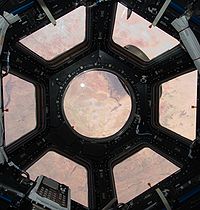 |
 |
|
|
The Cupola's design has been compared to the Millennium Falcon from the motion picture Star Wars.
|
Dmitri Kondratyev and Paolo Nespoli in the Cupola. Background left to right, Progress M-09M, Soyuz TMA-20, the Leonardo module and HTV-2.
|
Cupola is a seven window observatory, used to view Earth and docking spacecraft. Its name derives from the Italian word cupola, which means "dome". The Cupola project was started by NASA and Boeing, but cancelled due to budget cuts. A barter agreement between NASA and the ESA resulted in the Cupola's development being resumed in 1998 by the ESA. The module comes equipped with robotic workstations for operating the station's main robotic arm and shutters to protect its windows from damage caused by micrometeorites. It features 7 windows, with a 80-centimetre (31 in) round window, the largest window on the station. The distinctive design has been compared to the 'turret' of the fictitious Millennium Falcon in the motion picture Star Wars; the original prop lightsaber used by actor Mark Hamill as Luke Skywalker in the 1977 film was flown to the station in 2007, and the Falcon rockets commercial ships that come to the station use, are named after the Millennium Falcon itself.
Rassvet (Russian: Рассве́т; lit. "dawn"), also known as the Mini-Research Module 1 (MRM-1) (Russian: Малый исследовательский модуль, МИМ 1) and formerly known as the Docking Cargo Module (DCM), is similar in design to the Mir Docking Module launched on STS-74 in 1995. Rassvet is primarily used for cargo storage and as a docking port for visiting spacecraft. It was flown to the ISS aboard NASA's Space Shuttle Atlantis on the STS-132 mission and connected in May 2010, Rassvet is the only Russian owned module launched by NASA, to repay for the launch of Zarya, which is Russian designed and built, but partially paid for by NASA. Rassvet was launched with the Russian Nauka Laboratory's Experiments airlock temporarily attached to it, and spare parts for the European Robotic Arm.
Leonardo Permanent Multipurpose Module (PMM) The three NASA Space Shuttle MPLM cargo containers Leonardo, Raffaello and Donatello, were built for NASA in Turin, Italy by Alcatel Alenia Space, now Thales Alenia Space. The MPLMs are provided to the ISS programme by the Italy (independent of Italy's role as a member state of ESA) to NASA and are considered to be U.S. elements. In a bartered exchange for providing these containers, the U.S. has given Italy research time aboard the ISS out of the U.S. allotment in addition to that which Italy receives as a member of ESA. The Permanent Multipurpose Module was created by converting Leonardo into a module that could be permanently attached to the station.
Scheduled additional modules
Nauka (Russian: Нау́ка; lit. Science), also known as the Multipurpose Laboratory Module (MLM) or FGB-2, (Russian: Многофункциональный лабораторный модуль, or МЛМ), is the major Russian laboratory module. It is scheduled to arrive at the station in 2014 and will replace PIRS. Prior to the arrival of the Nauka, a progress robot spacecraft will dock with PIRS, depart with that module, and both will be discarded. It contains an additional set of life support systems and orientation control. Originally it would have routed power from the single Science-and-Power Platform, but that single module design changed over the first ten years of the ISS mission, and the two science modules which attach to Nauka via the Node Module each incorporate their own large solar arrays to power Russian science experiments in the ROS. Nauka's mission has changed over time. During the mid-1990s, it was intended as a backup for the FGB, and later as a universal docking module (UDM); its docking ports will be able to support automatic docking of both space craft, additional modules and fuel transfer. Nauka is a module in the 20 ton class and has its own engines. Smaller ISS modules (less than 10 tons) which dock to the ROS do not have engines of their own, but rely for propulsion upon the spaceship that brings them to the station. Zvezda and Zarya, like Nauka, weigh about 20 tons each and are launched by the larger Proton rockets rather than by Soyuz rockets. They are the only 3 modules on the ISS that contain engines, or navigation computers with star, sun and horizon sensors, to enable flight and station-keeping. Nauka will be separated from the ISS before de-orbit, together with support modules, and become the OPSEK space station.
Node Module (UM)/(NM) This 4-ton ball shaped module will support the docking of two scientific and power modules during the final stage of the station assembly and provide the Russian segment additional docking ports to receive Soyuz TMA (transportation modified anthropometric) and Progress M spacecraft. NM is to be incorporated into the ISS in 2014. It will be integrated with a special version of the Progress cargo ship and launched by a standard Soyuz rocket. The Progress would use its own propulsion and flight control system to deliver and dock the Node Module to the nadir (Earth-facing) docking port of the Nauka MLM/FGB-2 module. One port is equipped with an active hybrid docking port, which enables docking with the MLM module. The remaining five ports are passive hybrids, enabling docking of Soyuz and Progress vehicles, as well as heavier modules and future spacecraft with modified docking systems. However more importantly, the node module was conceived to serve as the only permanent element of the future Russian successor to the ISS, OPSEK. Equipped with six docking ports, the Node Module would serve as a single permanent core of the future station with all other modules coming and going as their life span and mission required. This would be a progression beyond the ISS and Russia's modular MIR space station, which are in turn more advanced than early monolithic first generation stations such as Skylab, and early Salyut and Almaz stations.
Science Power Modules 1 & 2 (NEM-1, NEM-2) (Russian: Научно-Энергетический Модуль-1 и -2)
Bigelow Expandable Activity Module (BEAM) is part of a contract with Bigelow Aerospace to provide a Bigelow Expandable Activity Module (BEAM), which is scheduled to arrive at the space station in 2015 for a two-year technology demonstration. BEAM is an inflatable module developed by Bigelow Aerospace will be attached to the International Space Station attached to the aft hatch of the port-side Tranquility module. During its two-year test run, instruments will measure its structural integrity and leak rate, along with temperature and radiation levels. The hatch leading into the module will remain mostly closed except for periodic visits by space station crew members for inspections and data collection. Following the test run, the module will be detached and jettisoned from the station.
Cancelled components
The US Habitation Module would have served as the station's living quarters. Instead, the sleep stations are now spread throughout the station. The US Interim Control Module and ISS Propulsion Module were intended to replace functions of Zvezda in case of a launch failure. The Russian Universal Docking Module, to which the cancelled Russian Research modules and spacecraft would have docked. The Russian Science Power Platform would have provided the Russian Orbital Segment with a power supply independent of the ITS solar arrays, and two Russian Research Modules that were planned to be used for scientific research.
Unpressurised elements
The ISS features a large number of external components that do not require pressurisation. The largest such component is the Integrated Truss Structure (ITS), to which the station's main solar arrays and thermal radiators are mounted. The ITS consists of ten separate segments forming a structure 108.5 m (356 ft) long.
The station in its complete form has several smaller external components, such as the six robotic arms, the three External Stowage Platforms (ESPs) and four ExPrESS Logistics Carriers (ELCs). Whilst these platforms allow experiments (including MISSE, the STP-H3 and the Robotic Refueling Mission) to be deployed and conducted in the vacuum of space by providing electricity and processing experimental data locally, the platforms' primary function is to store Orbital Replacement Units (ORUs). ORUs are spare parts that can be replaced when the item either passes its design life or fails. Examples of ORUs include pumps, storage tanks, antennas and battery units. Such units are replaced either by astronauts during EVA or by robotic arms. While spare parts were routinely transported to and from the station via Space Shuttle resupply missions, there was a heavy emphasis on ORU transport once the NASA Shuttle approached retirement. Several shuttle missions were dedicated to the delivery of ORUs, including STS-129, STS-133 and STS-134. As of January 2011, only one other mode of transportation of ORUs had been utilised – the Japanese cargo vessel HTV-2 – which delivered an FHRC and CTC-2 via its Exposed Pallet (EP).
There are also smaller exposure facilities mounted directly to laboratory modules; the JEM Exposed Facility serves as an external ' porch' for the Japanese Experiment Module complex, and a facility on the European Columbus laboratory provides power and data connections for experiments such as the European Technology Exposure Facility and the Atomic Clock Ensemble in Space. A remote sensing instrument, SAGE III-ISS, is due to be delivered to the station in 2014 aboard a Dragon capsule. The largest such scientific payload externally mounted to the ISS is the Alpha Magnetic Spectrometer (AMS), a particle physics experiment launched on STS-134 in May 2011, and mounted externally on the ITS. The AMS measures cosmic rays to look for evidence of dark matter and antimatter.
Cranes and robotic arms
Canadarm2, the largest robotic arm on the ISS, has a mass of 1,800 kilograms and is used to dock and manipulate spacecraft and modules on the USOS, and hold crew members and equipment during EVAs. The ROS does not require spacecraft or modules to be manipulated, as all spacecraft and modules dock automatically, and may be discarded the same way. Crew use the 2 Strela (Russian: Стрела; lit. Arrow) cargo cranes during EVAs for moving crew and equipment around the ROS. Each Strela crane has a mass of 45 kg. The Russian and Japanese laboratories both have airlocks and robotic arms.
The Integrated Truss Structure serves as a base for the main remote manipulator system called the Mobile Servicing System (MSS). This consists of the Mobile Base System (MBS), the Canadarm2, and Dextre. Dextre is a 1,500 kg agile robotic manipulator with two 'arms' which have 7 degrees of movement each, a 'torso' which bends at the waist and rotates at the base, a tool holster, lights and video. Staff on earth can operate Dextre via remote control, performing work without crew intervention. The MBS rolls along rails built into some of the ITS segments to allow the arm to reach all parts of the United States segment of the station. The MSS had its reach increased an Orbiter Boom Sensor System in May 2011, used to inspect tiles on the NASA shuttle, and converted for permanent station use. To gain access to the extreme extents of the Russian Segment the crew also placed a "Power Data Grapple Fixture" to the forward docking section of Zarya, so that the Canadarm2 may inchworm itself onto that point.
The European Robotic Arm, which will service the Russian Orbital Segment, will be launched alongside the Multipurpose Laboratory Module in 2012. The Japanese Experiment Module's Remote Manipulator System (JFM RMS), which services the JEM Exposed Facility, was launched on STS-124 and is attached to the JEM Pressurised Module.
Station systems
Life support
The critical systems are the atmosphere control system, the water supply system, the food supply facilities, the sanitation and hygiene equipment, and fire detection and suppression equipment. The Russian orbital segment's life support systems are contained in the Service Module Zvezda. Some of these systems are supplemented by equipment in the USOS. The MLM Nauka laboratory has a complete set of life support systems.
Atmospheric control systems
The atmosphere on board the ISS is similar to the Earth's. Normal air pressure on the ISS is 101.3 kPa (14.7 psi); the same as at sea level on Earth. An Earth-like atmosphere offers benefits for crew comfort, and is much safer than the alternative, a pure oxygen atmosphere, because of the increased risk of a fire such as that responsible for the deaths of the Apollo 1 crew. Earth-like atmospheric conditions have been maintained on all Russian and Soviet spacecraft.
The Elektron system aboard Zvezda and a similar system in Destiny generate oxygen aboard the station. The crew has a backup option in the form of bottled oxygen and Solid Fuel Oxygen Generation (SFOG) canisters, a chemical oxygen generator system. Carbon dioxide is removed from the air by the Vozdukh system in Zvezda. Other by-products of human metabolism, such as methane from the intestines and ammonia from sweat, are removed by activated charcoal filters.
Part of the ROS atmosphere control system is the oxygen supply, triple-redundancy is provided by the Elektron unit, solid fuel generators, and stored oxygen. The Elektron unit is the primary oxygen supply, O2 and H2 are produced by electrolysis, with the H2 being vented overboard. The 1 kW system uses approximately 1 litre of water per crew member per day from stored water from Earth, or water recycled from other systems. MIR was the first spacecraft to use recycled water for oxygen production. The secondary oxygen supply is provided by burning O2-producing Vika cartridges (see also ISS ECLSS). Each 'candle' takes 5–20 minutes to decompose at 450–500 °C, producing 600 litres of O2. This unit is manually operated.
The US orbital segment has redundant supplies of oxygen, from a pressurised storage tank on the Quest airlock module delivered in 2001, supplemented ten years later by ESA built Advanced Closed-Loop System (ACLS) in the Tranquility module (Node 3), which produces O2 by electrolysis. Hydrogen produced is combined with carbon dioxide from the cabin atmosphere and converted to water and methane.
Food
Most of the food on board is vacuum sealed in plastic bags. Cans are too heavy and expensive to transport, so there are not as many. The preserved food is generally not held in high regard by the crew, and when combined with the reduced sense of taste in a microgravity environment, a great deal of effort is made to make the food more palatable. More spices are used than in regular cooking, and the crew looks forward to the arrival of any ships from Earth, as they bring fresh fruit and vegetables with them. Care is taken that foods do not create crumbs. Sauces are often used to ensure station equipment is not contaminated. Each crew member has individual food packages and cooks them using the on-board galley. The galley features two food warmers, a refrigerator added in November 2008, and a water dispenser that provides both heated and unheated water. Drinks are provided in dehydrated powder form and are mixed with water before consumption. Drinks and soups are sipped from plastic bags with straws, while solid food is eaten with a knife and fork, which are attached to a tray with magnets to prevent them from floating away. Any food that does float away, including crumbs, must be collected to prevent it from clogging up the station's air filters and other equipment.
Hygiene
Showers on space stations were introduced in the early 1970s on Skylab and Salyut 3. By Salyut 6, in the early 1980s, the crew complained of the complexity of showering in space, which was a monthly activity. The ISS does not feature a shower; instead, crewmembers wash using a water jet and wet wipes, with soap dispensed from a toothpaste tube-like container. Crews are also provided with rinseless shampoo and edible toothpaste to save water.
There are two space toilets on the ISS, both of Russian design, located in Zvezda and Tranquility. These Waste and Hygiene Compartments use a fan-driven suction system similar to the Space Shuttle Waste Collection System. Astronauts first fasten themselves to the toilet seat, which is equipped with spring-loaded restraining bars to ensure a good seal. A lever operates a powerful fan and a suction hole slides open: the air stream carries the waste away. Solid waste is collected in individual bags which are stored in an aluminium container. Full containers are transferred to Progress spacecraft for disposal. Liquid waste is evacuated by a hose connected to the front of the toilet, with anatomically correct "urine funnel adapters" attached to the tube so both men and women can use the same toilet. Waste is collected and transferred to the Water Recovery System, where it is recycled back into drinking water.
Power and thermal control
Double-sided solar, or Photovoltaic arrays, provide electrical power for the ISS. These bifacial cells are more efficient and operate at a lower temperature than single-sided cells commonly used on Earth, by collecting sunlight on one side and light reflected off the Earth on the other.
The Russian segment of the station, like the Space Shuttle and most spacecraft, uses 28 volt DC from four rotating solar arrays mounted on Zarya and Zvezda. The USOS uses 130–180 V DC from the USOS PV array, power is stabilised and distributed at 160 V DC and converted to the user-required 124 V DC. The higher distribution voltage allows smaller, lighter conductors, at the expense of crew safety. The ROS uses low voltage. The two station segments share power with converters.
The USOS solar arrays are arranged as four wing pairs, with each wing producing nearly 32.8 kW. These arrays normally track the sun to maximise power generation. Each array is about 375 m2 (450 yd2) in area and 58 metres (63 yd) long. In the complete configuration, the solar arrays track the sun by rotating the alpha gimbal once per orbit while the beta gimbal follows slower changes in the angle of the sun to the orbital plane. The Night Glider mode aligns the solar arrays parallel to the ground at night to reduce the significant aerodynamic drag at the station's relatively low orbital altitude.
The station uses rechargeable nickel-hydrogen batteries (NiH2) for continuous power during the 35 minutes of every 90 minute orbit that it is eclipsed by the Earth. The batteries are recharged on the day side of the Earth. They have a 6.5 year lifetime (over 37,000 charge/discharge cycles) and will be regularly replaced over the anticipated 20-year life of the station.
The station's large solar panels generate a high potential voltage difference between the station and the ionosphere. This could cause arcing through insulating surfaces and sputtering of conductive surfaces as ions are accelerated by the spacecraft plasma sheath. To mitigate this, plasma contactor units (PCU)s create current paths between the station and the ambient plasma field.
The large amount of electrical power consumed by the station's systems and experiments is turned almost entirely into heat. The heat which can be dissipated through the walls of the stations modules is insufficient to keep the internal ambient temperature within comfortable, workable limits. Ammonia is continuously pumped through pipework throughout the station to collect heat, and then into external radiators exposed to the cold of space, and back into the station.
The International Space Station (ISS) External Active Thermal Control System (EATCS) maintains an equilibrium when the ISS environment or heat loads exceed the capabilities of the Passive Thermal Control System (PTCS). Note Elements of the PTCS are external surface materials, insulation such as MLI, or Heat Pipes. The EATCS provides heat rejection capabilities for all the US pressurised modules, including the JEM and COF as well as the main power distribution electronics of the S0, S1 and P1 Trusses. The EATCS consists of two independent Loops (Loop A & Loop B), they both use mechanically pumped Ammonia in fluid state, in closed-loop circuits. The EATCS is capable of rejecting up to 70 kW, and provides a substantial upgrade in heat rejection capacity from the 14 kW capability of the Early External Active Thermal Control System (EEATCS) via the Early Ammonia Servicer (EAS), which was launched on STS-105 and installed onto the P6 Truss.
Communications and computers
Radio communications provide telemetry and scientific data links between the station and Mission Control Centres. Radio links are also used during rendezvous and docking procedures and for audio and video communication between crewmembers, flight controllers and family members. As a result, the ISS is equipped with internal and external communication systems used for different purposes.
The Russian Orbital Segment communicates directly with the ground via the Lira antenna mounted to Zvezda. The Lira antenna also has the capability to use the Luch data relay satellite system. This system, used for communications with Mir, fell into disrepair during the 1990s, and as a result is no longer in use, although two new Luch satellites—Luch-5A and Luch-5B—are planned for launch in 2011 to restore the operational capability of the system. Another Russian communications system is the Voskhod-M, which enables internal telephone communications between Zvezda, Zarya, Pirs, Poisk and the USOS, and also provides a VHF radio link to ground control centres via antennas on Zvezda's exterior.
The US Orbital Segment (USOS) makes use of two separate radio links mounted in the Z1 truss structure: the S band (used for audio) and Ku band (used for audio, video and data) systems. These transmissions are routed via the United States Tracking and Data Relay Satellite System (TDRSS) in geostationary orbit, which allows for almost continuous real-time communications with NASA's Mission Control Centre (MCC-H) in Houston. Data channels for the Canadarm2, European Columbus laboratory and Japanese Kibō modules are routed via the S band and Ku band systems, although the European Data Relay Satellite System and a similar Japanese system will eventually complement the TDRSS in this role. Communications between modules are carried on an internal digital wireless network.
UHF radio is used by astronauts and cosmonauts conducting EVAs. UHF is employed by other spacecraft that dock to or undock from the station, such as Soyuz, Progress, HTV, ATV and the Space Shuttle (except the shuttle also makes use of the S band and Ku band systems via TDRSS), to receive commands from Mission Control and ISS crewmembers. Automated spacecraft are fitted with their own communications equipment; the ATV uses a laser attached to the spacecraft and equipment attached to Zvezda, known as the Proximity Communications Equipment, to accurately dock to the station.
The ISS is equipped with approximately 100 IBM and Lenovo ThinkPad model A31 and T61P laptop computers. Each computer is a commercial off-the-shelf purchase which is then modified for safety and operation including updates to connectors, cooling and power to accommodate the station's 28V DC power system and weightless environment. Heat generated by the laptops doesn't rise, but stagnates surrounding the laptop, so additional forced ventilation is required. Laptops aboard the ISS are connected to the station's wireless LAN via Wi-Fi and are connected to the ground at 3 Mbit/s up and 10 Mbit/s down, comparable to home DSL connection speeds.
Station operations
Expeditions and private flights
The station crew "are our representatives spearheading humanity's exploration of new spaces and possibilities for our future" according to Pope Benedict XVI. Each permanent crew is given an expedition number. Expeditions run up to six months, from launch until undocking, an 'increment' covers the same time period, but includes cargo ships and all activities. Expeditions 1 to 6 consisted of 3 person crews, Expeditions 7 to 12 were reduced to the safe minimum of two following the destruction of the NASA Shuttle Columbia. From Expedition 13 the crew gradually increased to 6 around 2010. With the arrival of the American Commercial Crew vehicles in the middle of the 2010s, expedition size may be increased to seven crew members, the number ISS is designed for.
Sergei Krikalev, member of Expedition 1 and Commander of Expedition 11 has spent more time in space than anyone else, a total of 803 days and 9 hours and 39 minutes. His awards include the Order of Lenin, Hero of the Soviet Union, Hero of the Russian Federation, and 4 NASA medals. On 16 August 2005 at 1:44 am EDT he passed the record of 748 days held by Sergei Avdeyev, who had 'time travelled' 1/50th of a second into the future on board MIR. He participated in psychosocial experiment SFINCSS-99 (Simulation of Flight of International Crew on Space Station), which examined inter-cultural and other stress factors effecting integration of crew in preparation for the ISS spaceflights. Commander Michael Fincke is the U.S. space endurance record holder with a total of 382 days.
Travelers who pay for their own passage into space are called spaceflight participants by the RSA and NASA, and are sometimes referred to as space tourists, a term they generally dislike. All seven were transported to the ISS on Russian Soyuz spacecraft. When professional crews change over in numbers not divisible by the three seats in a Soyuz, and a short-stay crewmember is not sent, the spare seat is sold by MirCorp through Space Adventures. When the space shuttle retired in 2011, and the station's crew size was reduced to 6, space tourism was halted, as the partners relied on Russian transport seats for access to the station. Soyuz flight schedules increase after 2013, allowing 5 Soyuz flights (15 seats) with only two expeditions (12 seats) required. The remaining seats are sold for around US$40 million to members of the public who can pass a medical. ESA and NASA criticised private spaceflight at the beginning of the ISS, and NASA initially resisted training Dennis Tito, the first man to pay for his own passage to the ISS. Toyohiro Akiyama was flown to Mir for a week, he was classed as a business traveller, as his employer, Tokyo Broadcasting System, paid for his ticket, and he gave a daily TV broadcast from orbit.
Anousheh Ansari ( Persian: انوشه انصاری) became the first Iranian in space and the first self-funded woman to fly to the station. Officials reported that her education and experience make her much more than a tourist, and her performance in training had been "excellent." Ansari herself dismisses the idea that she is a tourist. She did Russian and European studies involving medicine and microbiology during her 10 day stay. The documentary Space Tourists follows her journey to the station, where she fulfilled the childhood dream 'to leave our planet as a normal person and travel into outer space.' In the film, some Kazakhs are shown waiting in the middle of the steppes for four rocket stages to literally fall from the sky. Film-maker Christian Frei states "Filming the work of the Kazakh scrap metal collectors was anything but easy. The Russian authorities finally gave us a film permit in principle, but they imposed crippling preconditions on our activities. The real daily routine of the scrap metal collectors could definitely not be shown. Secret service agents and military personnel dressed in overalls and helmets were willing to re-enact their work for the cameras – in an idealised way that officials in Moscow deemed to be presentable, but not at all how it takes place in reality."
During his spaceflight, self funded traveler Richard Garriott placed a geocache while aboard the ISS. This is currently the only non-terrestrial geocache in existence.
Crew activities
A typical day for the crew begins with a wake-up at 06:00, followed by post-sleep activities and a morning inspection of the station. The crew then eats breakfast and takes part in a daily planning conference with Mission Control before starting work at around 08:10. The first scheduled exercise of the day follows, after which the crew continues work until 13:05. Following a one-hour lunch break, the afternoon consists of more exercise and work before the crew carries out its pre-sleep activities beginning at 19:30, including dinner and a crew conference. The scheduled sleep period begins at 21:30. In general, the crew works ten hours per day on a weekday, and five hours on Saturdays, with the rest of the time their own for relaxation or work catch-up.
The station provides crew quarters for each member of the expedition's crew, with two 'sleep stations' in the Zvezda and four more installed in Harmony. The American quarters are private, approximately person-sized soundproof booths. The Russian crew quarters include a small window, but do not provide the same amount of ventilation or block the same amount of noise as their American counterparts. A crewmember can sleep in a crew quarter in a tethered sleeping bag, listen to music, use a laptop, and store personal items in a large drawer or in nets attached to the module's walls. The module also provides a reading lamp, a shelf and a desktop. Visiting crews have no allocated sleep module, and attach a sleeping bag to an available space on a wall—it is possible to sleep floating freely through the station, but this is generally avoided because of the possibility of bumping into sensitive equipment. It is important that crew accommodations be well ventilated; otherwise, astronauts can wake up oxygen-deprived and gasping for air, because a bubble of their own exhaled carbon dioxide has formed around their heads.
Christmas on the International Space Station

Christmas is celebrated each year by the International Space Station crew, their families, and ground-staff. Crew are given time off duty according to their respective culture, religion and ethnicity. The Russian Orthodox Church celebrates Christmas according to the Julian calendar, whilst the Catholic Church uses the Gregorian calendar so the crew may celebrate Christmas more than once on the station choosing between 25 December or 6, 7 or 19 January.
Orbit and mission control
The ISS is maintained in a nearly circular orbit with a minimum mean altitude of 330 km (205 mi) and a maximum of 410 km (255 mi), in the centre of the Thermosphere, at an inclination of 51.6 degrees to Earth's equator, necessary to ensure that Russian Soyuz and Progress spacecraft launched from the Baikonur Cosmodrome may be safely launched to reach the station. Spent rocket stages must be dropped into uninhabited areas and this limits the directions rockets can be launched from the spaceport. The orbital inclination chosen was also low enough to allow American space shuttles launched from Florida to reach the ISS.
It travels at an average speed of 27,724 kilometres (17,227 mi) per hour, and completes 15.7 orbits per day. The station's altitude was allowed to fall around the time of each NASA shuttle mission. Orbital boost burns would generally be delayed until after the shuttle's departure. This allowed shuttle payloads to be lifted with the station's engines during the routine firings, rather than have the shuttle lift itself and the payload together to a higher orbit. This trade-off allowed heavier loads to be transferred to the station. After the retirement of the NASA shuttle, the nominal orbit of the space station was raised in altitude. Other, more frequent supply ships do not require this adjustment as they are substantially lighter vehicles.
Orbital boosting can be performed by the station's two main engines on the Zvezda service module, or Russian or European spacecraft docked to Zvezda's aft port. The ATV has been designed with the possibility of adding a second docking port to its other end, allowing it to remain at the ISS and still allow other craft to dock and boost the station. It takes approximately two orbits (three hours) for the boost to a higher altitude to be completed. In December 2008 NASA signed an agreement with the Ad Astra Rocket Company which may result in the testing on the ISS of a VASIMR plasma propulsion engine. This technology could allow station-keeping to be done more economically than at present.
The Russian Orbital Segment contains the station's engines and control bridge, which handles Guidance, Navigation and Control (ROS GNC) for the entire station. Initially, Zarya, the first module of the station, controlled the station until a short time after the Russian service module Zvezda docked and was transferred control. Zvezda contains the ESA built DMS-R Data Management System. Using two fault-tolerant computers (FTC), Zvezda computes the station's position and orbital trajectory using redundant Earth horizon sensors, Solar horizon sensors as well as Sun and star trackers. The FTCs each contain three identical processing units working in parallel and provide advanced fault-masking by majority voting. Zvezda uses gyroscopes and thrusters to turn itself around. Gyroscopes don't need propellant, rather they use electricity to 'store' momentum in flywheels by turning in the opposite direction to the station's movement. The USOS has its own computer controlled gyroscopes to handle the extra mass of that section. When gyroscopes 'saturate', reaching their maximum speed, thrusters are used to cancel out the stored momentum. During Expedition 10, an incorrect command was sent to the station's computer, using about 14 kilograms of propellant before the fault was noticed and fixed. When attitude control computers in the ROS and USOS don't communicate properly, it can result in a rare 'force fight' where the ROS GNC computer must ignore the USOS counterpart, which has no thrusters. When an ATV, Nasa Shuttle, or Soyuz is docked to the station, it can also be used to maintain station attitude such as for troubleshooting. Shuttle control was used exclusively during installation of the S3/S4 truss, which provides electrical power and data interfaces for the station's electronics.
The components of the ISS are operated and monitored by their respective space agencies at mission control centres across the globe, including:
- Roskosmos's Mission Control Centre at Korolyov, Moscow Oblast, controls the Russian Orbital Segment which handles Guidance, Navigation & Control for the entire Station., in addition to individual Soyuz and Progress missions.
- ESA's ATV Control Centre, at the Toulouse Space Centre (CST) in Toulouse, France, controls flights of the unmanned European Automated Transfer Vehicle.
- JAXA's JEM Control Centre and HTV Control Centre at Tsukuba Space Centre (TKSC) in Tsukuba, Japan, are responsible for operating the Japanese Experiment Module complex and all flights of the 'White Stork' HTV Cargo spacecraft, respectively.
- NASA's Mission Control Centre at Lyndon B. Johnson Space Centre in Houston, Texas, USA, serves as the primary control facility for the United States segment of the ISS and also controlled the Space Shuttle missions that visited the station.
- NASA's Payload Operations and Integration Centre at Marshall Space Flight Centre in Huntsville, Alabama, coordinates payload operations in the USOS.
- ESA's Columbus Control Centre at the German Aerospace Centre (DLR) in Oberpfaffenhofen, Germany, manages the European Columbus research laboratory.
- CSA's MSS Control at Saint-Hubert, Quebec, Canada, controls and monitors the Mobile Servicing System, or Canadarm2.
Repairs
Orbital Replacement Units (ORUs) are spare parts that can be readily replaced when a unit either passes its design life or fails. Examples of ORUs are pumps, storage tanks, controller boxes, antennas, and battery units. Some units can be replaced using robotic arms. Many are stored outside the station, either on small pallets called ExPRESS Logistics Carriers (ELCs) or share larger platforms called External Stowage Platforms which also hold science experiments. Both kinds of pallets have electricity as many parts which could be damaged by the cold of space require heating. The larger logistics carriers also have computer local area network connections (LAN) and telemetry to connect experiments. A heavy emphasis on stocking the USOS with ORU's occurred around 2011, before the end of the NASA shuttle program, as its commercial replacements, Cygnus and Dragon, carry one tenth to one quarter the payload.
Unexpected problems and failures have impacted the station's assembly time-line and work schedules leading to periods of reduced capabilities and, in some cases, could have forced abandonment of the station for safety reasons, had these problems not been resolved. During STS-120 on 2007, following the relocation of the P6 truss and solar arrays, it was noted during the redeployment of the array that it had become torn and was not deploying properly. An EVA was carried out by Scott Parazynski, assisted by Douglas Wheelock, the men took extra precautions to reduce the risk of electric shock, as the repairs were carried out with the solar array exposed to sunlight. The issues with the array were followed in the same year by problems with the starboard Solar Alpha Rotary Joint (SARJ), which rotates the arrays on the starboard side of the station. Excessive vibration and high-current spikes in the array drive motor were noted, resulting in a decision to substantially curtail motion of the starboard SARJ until the cause was understood. Inspections during EVAs on STS-120 and STS-123 showed extensive contamination from metallic shavings and debris in the large drive gear and confirmed damage to the large metallic race ring at the heart of the joint, and so the joint was locked to prevent further damage. Repairs to the joint were carried out during STS-126 with lubrication of both joints and the replacement of 11 out of 12 trundle bearings on the joint.
2009 saw damage to the S1 radiator, one of the components of the station's cooling system. The problem was first noticed in Soyuz imagery in September 2008, but was not thought to be serious. The imagery showed that the surface of one sub-panel has peeled back from the underlying central structure, possibly due to micro-meteoroid or debris impact. It is also known that a Service Module thruster cover, jettisoned during an EVA in 2008, had struck the S1 radiator, but its effect, if any, has not been determined. On 15 May 2009 the damaged radiator panel's ammonia tubing was mechanically shut off from the rest of the cooling system by the computer-controlled closure of a valve. The same valve was used immediately afterwards to vent the ammonia from the damaged panel, eliminating the possibility of an ammonia leak from the cooling system via the damaged panel.
Early on 1 August 2010, a failure in cooling Loop A (starboard side), one of two external cooling loops, left the station with only half of its normal cooling capacity and zero redundancy in some systems. The problem appeared to be in the ammonia pump module that circulates the ammonia cooling fluid. Several subsystems, including two of the four CMGs, were shut down.
Planned operations on the ISS were interrupted through a series of EVAs to address the cooling system issue. A first EVA on 7 August 2010, to replace the failed pump module, was not fully completed due to an ammonia leak in one of four quick-disconnects. A second EVA on 11 August successfully removed the failed pump module. A third EVA was required to restore Loop A to normal functionality.
The USOS's cooling system is largely built by the American company Boeing, which is also the manufacturer of the failed pump.
An air leak from the USOS in 2004, the venting of fumes from an Elektron oxygen generator in 2006, and the failure of the computers in the ROS in 2007 during STS-117 which left the station without thruster, Elektron, Vozdukh and other environmental control system operations, the root cause of which was found to be condensation inside the electrical connectors leading to a short-circuit.
The four Main Bus Switching Units (MBSUs, located in the S0 truss), control the routing of power from the four solar array wings to the rest of the ISS. In late 2011 MBSU-1, while still routing power correctly, ceased responding to commands or sending data confirming its health, and was scheduled to be swapped out at the next available EVA. In each MBSU, two power channels feed 160V DC from the arrays to two DC-to-DC power converters (DDCUs) that supply the 124V power used in the station. A spare MBSU was already on board, but the 30 August 2012 EVA failed to be completed when a bolt being tightened to finish installation of the spare unit jammed before electrical connection was secured. The loss of MBSU-1 limits the station to 75% of its normal power capacity, requiring minor limitations in normal operations until the problem can be addressed.
As of 2 September 2012, a second EVA to tighten the balky bolt, completing the installation of the replacement MBSU-1 in an attempt to restore full power, has been scheduled for Wednesday, Yet in the meanwhile, a third solar array wing has gone off line due to some fault in that array's Direct Current Switching Unit (DCSU) or its associated system, further reducing ISS power to just five of the eight solar array wings for the first time in several years.
On 5 September 2012, in a second, 6 hr, EVA to replace MBSU-1, astronauts Sunita Williams and Akihiko Hoshide successfully restored the ISS to 100% power.
Fleet operations
Progress M-18M (ISS-50P) was the 50th progress robot to arrive at the ISS, including M-MIM2 and M-SO1 which installed modules. Thirty-five flights of the retired NASA Space Shuttle were made to the station. TMA-07M is the 33rd Soyuz flight, and there have been three European ATV and three Japanese Kounotori 'White Stork' arrivals.
Currently docked/berthed
Scheduled launches and dockings/berthings
All dates are UTC. Dates are the earliest possible dates and may change. Forward ports are at the front of the station according to its normal direction of travel and orientation ( attitude). Aft is at the rear of the station, used by spacecraft boosting the station's orbit. Nadir is closest the Earth, Zenith is on top.
Uncrewed cargoships are in light blue. Crewed spacecraft are in light green. Modules are white. Spacecraft operated by government agencies are indicated with 'Gov', while 'Com' denotes those operated under commercial arrangements.
| Spacecraft and operator | Spaceport and mission | Launch | Docking/Berthing Port | ||||
|---|---|---|---|---|---|---|---|
| 2013 launches | 2013 | ||||||
| Gov | Progress M-19M | Baikonur | Progress 51 Cargo | April | Pirs nadir | ||
| Gov | Soyuz TMA-09M | Baikonur | Expedition 36/ 37 | May | Rassvet nadir | ||
| Gov | Albert Einstein | French Guiana | ATV-4 Cargo | June | Zvezda aft | ||
| Com | Cygnus COTS Demo | MARS (in USA) | Cygnus COTS Demo | July | Harmony nadir | ||
| Gov | Kounotori 4 'White Stork' | Tanegashima | HTV-4 Cargo | August | Harmony | ||
| Com | SpaceX CRS-3 | Cape Canaveral | Dragon 3 Cargo | October | Harmony nadir | ||
| Gov | Proton | Baikonur | Module Nauka MLM | December | Zvezda nadir | ||
| 2014 onwards | 2014 | ||||||
| Com | SpaceX CRS-4 | Cape Canaveral | Dragon 4 Cargo | April | Harmony nadir | ||
| Gov | Progress M-UM & Soyuz-2.1b | Baikonur | Module Node Module | 2014 | Nauka nadir | ||
| Gov | Proton-M (or Angara A5) | Baikonur | Module NEM-1 | 2014 | Node Module nadir | ||
| Gov | Proton-M (or Angara A5) | Baikonur | Module NEM-2 | 2015 | Node Module nadir | ||
| Com | Dragon CRS Spx-8 | Cape Canaveral | Bigelow Expandable Activity Module | 2015 | Harmony nadir | ||
Docking
All Russian manned spacecraft, modules, and progress craft are able to rendezvous and dock to the space station without human intervention. Using Kurs radar they detect and intercept the ISS from over 200 kilometres away. The European ATV uses star sensors and GPS to determine its intercept course. When it catches up it then uses laser equipment to optically recognise Zvezda, with Russian Kurs redundancy. Crew supervise these craft, but do not intervene except to send abort commands in emergencies. The Japanese H-II Transfer Vehicle parks itself in progressively closer orbits to the station, and then awaits 'approach' commands from the crew, until it is close enough for the crew to grapple it with a robotic arm and berth it to the USOS. The American Space Shuttle was manually docked, and on missions with a cargo container, the container would be berthed to the Station with the use of manual robotic arms. Berthed craft can transfer International Standard Payload Racks. Japanese spacecraft berth for one to two months. Russian and European Supply craft can remain at the ISS for six months, allowing great flexibility in crew time for loading and unloading of supplies and trash. NASA Shuttles could remain docked for 11–12 days.
The American manual approach to docking allows greater initial flexibility and less complexity. The downside to this mode of operation is that each mission becomes unique and requires specialised training and planning, making the process more labour-intensive and expensive. The Russians pursued an automated methodology that used the crew in override or monitoring roles. Although the initial development costs were high, the system has become very reliable with standardisations that provide significant cost benefits in repetitive routine operations. An automated approach could allow assembly of modules orbiting other worlds prior to manned missions.
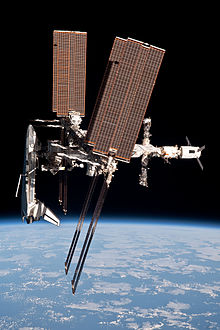
Soyuz manned spacecraft for crew rotation also serve as lifeboats for emergency evacuation, they are replaced every six months and have been used once to remove excess crew after the Columbia disaster. Expeditions require, on average, 2 722 kg of supplies, and as of 9 March 2011, crews had consumed a total of around 22 000 meals. Soyuz crew rotation flights and Progress resupply flights visit the station on average two and three times respectively each year, with the ATV and HTV planned to visit annually from 2010 onwards. Following retirement of the NASA Shuttle Cygnus and Dragon were contracted to fly cargo to the station.
From 26 February 2011 to 7 March 2011 four of the governmental partners (United States, ESA, Japan and Russia) had their spacecraft (NASA Shuttle, ATV, HTV, Progress and Soyuz) docked at the ISS, the only time this has happened to date. On 25 May 2012, SpaceX became the world's first privately held company to send a cargo load, via the Dragon spacecraft, to the International Space Station.
Launch and docking windows
Prior to a ship's docking to the ISS, navigation and orientation (GNC) is handed over to the ground control of the ships' country of origin. GNC is set to allow the station to drift in space, rather than fire its thrusters or turn using gyroscopes. The solar panels of the station are turned edge-on to the incoming ships, so residue from its thrusters does not damage the cells. When a NASA shuttle docked to the station, other ships were grounded, as the carbon wingtips, cameras, windows, and instruments aboard the shuttle were at too much risk from damage from thruster residue from other ships movements.
Approximately 30% of NASA shuttle launch delays were caused by poor weather. Occasional priority was given to the Soyuz arrivals at the station where the Soyuz carried crew with time-critical cargoes such as biological experiment materials, also causing shuttle delays. Departure of the NASA shuttle was often delayed or prioritised according to weather over its two landing sites. Whilst the Soyuz is capable of landing anywhere, anytime, its planned landing time and place is chosen to give consideration to helicopter pilots and ground recovery crew, to give acceptable flying weather and lighting conditions. Soyuz launches occur in adverse weather conditions, however the cosmodrome had been shut down on occasions when buried by snow drifts up to 6 metres in depth, hampering ground operations.
Sightings
Naked eye
The ISS is visible to the naked eye before sunrise or after sunset as a slow-moving, bright white dot, crossing the sky in 2 to 5 minutes. This happens before dawn and after dusk when the ISS is sunlit but the ground and sky are dark, which is typically the case up to a few hours after sunset or before sunrise. Because of the size of its reflective surface area, the ISS is the brightest man made object in the sky excluding flares, with an approximate maximum brightness of −4 when overhead, similar to Venus. The ISS, like many satellites including the Iridium constellation, can also produce flares as sunlight glints off reflective surfaces as it orbits of up to 8 or 16 times the brightness of Venus. The ISS is also visible during broad daylight conditions, albeit with a great deal more effort.
Tools are provided by a number of websites such as Heavens-Above as well as smartphone applications that use the known orbital data and the observer's longitude and latitude to predict when the ISS will be visible (weather permitting), where the station will appear to rise to the observer, the altitude above the horizon it will reach and the duration of the pass before the station disappears to the observer either by setting below the horizon or entering into Earth's shadow.
In November 2012 NASA launched its 'Spot the Station' service, which sends people text and email alerts when the station is due to fly above their town.
The station is visible from 95% of the inhabited land on Earth, but is not visible from extreme northern or southern latitudes. OPSEK will orbit at a higher inclination of 71 degrees, allowing observation to and from all of the Russian federation.
Astrophotography
Using a telescope mounted camera to photograph the station is a popular hobby for astronomers, whilst using a mounted camera to photograph the Earth and stars is a popular hobby for crew. The use of a telescope or binoculars allows viewing of the ISS during daylight hours.
Parisian engineer and astrophotographer Thierry Legault, known for his photos of spaceships crossing the sun (called occultation), travelled to Oman in 2011, to photograph the sun, moon and space station all lined up. Legault, who received the Marius Jacquemetton award from the Société astronomique de France in 1999, and other hobbyists, use websites that predict when the ISS will pass in front of the Sun or Moon and what location those passes will be visible from.
Crew health and safety
Radiation
The ISS is partially protected from the space environment by the Earth's magnetic field. From an average distance of about 70,000 km, depending on Solar activity, the magnetosphere begins to deflect solar wind around the Earth and ISS. However, solar flares are still a hazard to the crew, who may receive only a few minutes warning. The crew of Expedition 10 took shelter as a precaution in 2005 in a more heavily shielded part of the ROS designed for this purpose during the initial 'proton storm' of an X-3 class solar flare, but without the limited protection of the Earth's magnetosphere, interplanetary manned missions are especially vulnerable.
Subatomic charged particles, primarily protons from cosmic rays and solar wind, are normally absorbed by the earth's atmosphere. When they interact in sufficient quantity, their effect becomes visible to the naked eye in a phenomenon called an aurora. Without the protection of the Earth's atmosphere, which absorbs this radiation, crews are exposed to about 1 millisievert each day, which is about the same as someone would get in a year on Earth from natural sources. This results in a higher risk of astronauts developing cancer. Radiation can penetrate living tissue, damage DNA, and cause damage to the chromosomes of lymphocytes. These cells are central to the immune system, and so any damage to them could contribute to the lowered immunity experienced by astronauts. Radiation has also been linked to a higher incidence of cataracts in astronauts. Protective shielding and protective drugs may lower the risks to an acceptable level.
The radiation levels experienced on the ISS are about five times greater than those experienced by airline passengers and crew. The Earth's electromagnetic field provides almost the same level of protection against solar and other radiation in low Earth orbit as in the stratosphere. Airline passengers, however, experience this level of radiation for no more than 15 hours for the longest intercontinental flights. For example, on a 12 hour flight an airline passenger would experience 0.1 millisieverts of radiation, or a rate of 0.2 millisieverts per day; only 1/5 the rate experienced by an astronaut in LEO.
Stress
There has been considerable evidence that psychosocial stressors are among the most important impediments to optimal crew morale and performance. Cosmonaut Valery Ryumin, twice Hero of the Soviet Union, wrote in his journal during a particularly difficult period onboard the Salyut 6 space station: “All the conditions necessary for murder are met if you shut two men in a cabin measuring 18 feet by 20 and leave them together for two months.”
NASA's interest in psychological stress caused by space travel, initially studied when their manned missions began, was rekindled when astronauts joined cosmonauts on the Russian space station Mir. Common sources of stress in early American missions included maintaining high performance while under public scrutiny, as well as isolation from peers and family. The latter is still often a cause of stress on the ISS, such as when NASA Astronaut Daniel Tani's mother died in a car accident, and when Michael Fincke was forced to miss the birth of his second child.
A study of the longest spaceflight concluded that the first three weeks represent a critical period where attention is adversely affected because of the demand to adjust to the extreme change of environment. While Skylab's 3 crews remained one, two, and three months respectively, long term crews on Salyut 6, Salyut 7, and the ISS last about five to six months while MIR's expeditions often lasted longer. The ISS working environment includes further stress caused by living and working in cramped conditions with people from very different cultures who speak a different language. First generation space stations had crews who spoke a single language, while second and third-generation stations have crew from many cultures who speak many languages. The ISS is unique because visitors are not classed automatically into 'host' or 'guest' categories as with previous stations and spacecraft, and may not suffer from feelings of isolation in the same way. Crew members with a military pilot background and those with an academic science background or teachers and politicians may have problems understanding each other’s jargon and worldview.
Medical
Medical effects of long-term weightlessness include muscle atrophy, deterioration of the skeleton (osteopenia), fluid redistribution, a slowing of the cardiovascular system, decreased production of red blood cells, balance disorders, and a weakening of the immune system. Lesser symptoms include loss of body mass, and puffiness of the face.
Sleep is disturbed on the ISS regularly due to mission demands, such as incoming or departing ships. Sound levels in the station are unavoidably high; because the atmosphere is unable to thermosyphon, fans are required at all times to allow processing of the atmosphere which would stagnate in the freefall (zero-g) environment.
To prevent some of these adverse physiological effects, the station is equipped with two treadmills (including the COLBERT), and the aRED (advanced Resistive Exercise Device) which enables various weightlifting exercises which add muscle but do nothing for bone density, and a stationary bicycle; each astronaut spends at least two hours per day exercising on the equipment. Astronauts use bungee cords to strap themselves to the treadmill.
Orbital debris
 |
 |
|
|
A 7 gram object (shown in centre) shot at 7 km/s (the orbital velocity of the ISS) made this 15 cm crater in a solid block of aluminium.
|
Radar-trackable objects including debris, note distinct ring of Geostationary satellites
|
At the low altitudes at which the ISS orbits there is a variety of space debris, consisting of many different objects including entire spent rocket stages, defunct satellites, explosion fragments—including materials from anti-satellite weapon tests, paint flakes, slag from solid rocket motors, coolant released by RORSAT nuclear-powered satellites and some of the 750,000,000 small needles from the American military Project West Ford. These objects, in addition to natural micrometeoroids, are a significant threat. Large objects could destroy the station, but are less of a threat as their orbits can be predicted. Objects too small to be detected by optical and radar instruments, from approximately 1 cm down to microscopic size, number in the trillions. Despite their small size, some of these objects are still a threat because of their kinetic energy and direction in relation to the station. Spacesuits of spacewalking crew could puncture, causing exposure to vacuum.
The station's shields and structure are divided between the ROS and the USOS, with completely different designs. On the USOS, a thin aluminium sheet is held apart from the hull, the sheet causes objects to shatter into a cloud before hitting the hull thereby spreading the energy of the impact. On the ROS, a carbon plastic honeycomb screen is spaced from the hull, an aluminium honeycomb screen is spaced from that, with a screen-vacuum thermal insulation covering, and glass cloth over the top. It's about 50% less likely to be punctured, and crew move to the ROS when the station is under threat. Punctures on the ROS would be contained within the panels which are 70 cm square.
Space debris objects are tracked remotely from the ground, and the station crew can be notified. This allows for a Debris Avoidance Manoeuvre (DAM) to be conducted, which uses thrusters on the Russian Orbital Segment to alter the station's orbital altitude, avoiding the debris. DAMs are not uncommon, taking place if computational models show the debris will approach within a certain threat distance. Eight DAMs had been performed prior to March 2009, the first seven between October 1999 and May 2003. Usually the orbit is raised by one or two kilometres by means of an increase in orbital velocity of the order of 1 m/s. Unusually there was a lowering of 1.7 km on 27 August 2008, the first such lowering for 8 years. There were two DAMs in 2009, on 22 March and 17 July. If a threat from orbital debris is identified too late for a DAM to be safely conducted, the station crew close all the hatches aboard the station and retreat into their Soyuz spacecraft, so that they would be able to evacuate in the event the station was seriously damaged by the debris. This partial station evacuation has occurred on 13 March 2009, 28 June 2011 and 24 March 2012. Ballistic panels, also called micrometeorite shielding, are incorporated into the station to protect pressurised sections and critical systems. The type and thickness of these panels varies depending upon their predicted exposure to damage.
Politics
International co-operation
International co-operation in space began between the United States and the Soviet Union in 1972, with the Apollo-Soyuz Test Project. This cooperative venture resulted in the July 1975 docking of Soyuz 19 with an Apollo spacecraft. From 1978–1987 the USSR's Interkosmos programme included allied Warsaw Pact countries, and countries which were not Soviet allies, such as India, Syria and France, in manned and unmanned missions to Space stations Salyut 6 and 7. In 1986 the USSR extended this co-operation to a dozen countries in the MIR programme. In 1994–98 NASA Space Shuttles and crew visited MIR in the Shuttle-Mir programme. In 1998 the ISS programme began.
In March 2012, a meeting in Quebec City between the leaders of the Canadian Space Agency and those from Japan, Russia, the United States and involved European nations resulted in a renewed pledge to maintain the International Space Station until at least 2020. NASA reports to be still committed to the principles of the mission but also to use the station in new ways, which were not elaborated. CSA President Steve MacLean stated his belief that the station's Canadarm will continue to function properly until 2028, alluding to Canada's likely extension of its involvement beyond 2020.
Ownership of modules, station usage by participant nations, and responsibilities for station resupply are established by the Space Station Intergovernmental Agreement (IGA). This international treaty was signed on 28 January 1998 by the United States of America, Russia, Japan, Canada and eleven member states of the European Space Agency (Belgium, Denmark, France, Germany, Italy, The Netherlands, Norway, Spain, Sweden, Switzerland, and the United Kingdom). With the exception of the United Kingdom, all of the signatories went on to contribute to the Space Station project. A second layer of agreements was then achieved, called Memoranda of Understanding (MOU), between NASA and ESA, CSA, RKA and JAXA. These agreements are then further split, such as for the contractual obligations between nations, and trading of partners' rights and obligations. Use of the Russian Orbital Segment is also negotiated at this level.
In addition to these main intergovernmental agreements, Brazil originally joined the programme as a bilateral partner of the United States by a contract with NASA to supply hardware. In return, NASA would provide Brazil with access to its ISS facilities on-orbit, as well as a flight opportunity for one Brazilian astronaut during the course of the ISS programme. However, due to cost issues, the subcontractor Embraer was unable to provide the promised ExPrESS pallet, and Brazil left the programme. Italy has a similar contract with NASA to provide comparable services, although Italy also takes part in the programme directly via its membership in ESA. Expanding the partnership would require unanimous agreement of the existing partners. Chinese participation has been prevented by unilateral US opposition. The heads of both the South Korean and Indian space agency ISRO announced at the first plenary session of the 2009 International Astronautical Congress that their nations wished to join the ISS programme, with talks due to begin in 2010. The heads of agency also expressed support for extending ISS lifetime. European countries not part of the programme will be allowed access to the station in a three-year trial period, ESA officials say.
The Russian part of the station is operated and controlled by the Russian Federation's space agency and provides Russia with the right to nearly one-half of the crew time for the ISS. The allocation of remaining crew time (three to four crew members of the total permanent crew of six) and hardware within the other sections of the station is as follows: Columbus: 51% for the ESA, 46.7% for NASA, and 2.3% for CSA. Kibō: 51% for the JAXA, 46.7% for NASA, and 2.3% for CSA. Destiny: 97.7% for NASA and 2.3% for CSA. Crew time, electrical power and rights to purchase supporting services (such as data upload and download and communications) are divided 76.6% for NASA, 12.8% for JAXA, 8.3% for ESA, and 2.3% for CSA.
China
China is not an ISS partner, and no Chinese nationals have been aboard. China has its own contemporary manned space program, Project 921, and has carried out cooperation and exchanges with countries such as Russia and Germany in manned and unmanned space projects. China launched its first experimental space station, Tiangong 1, in September 2011, and has officially initiated the permanently manned Chinese space station project.
In 2007, Chinese vice minister of science and technology Li Xueyong said that China would like to participate in the ISS. In 2010, ESA Director-General Jean-Jacques Dordain stated his agency was ready to propose to the other 4 partners that China be invited to join the partnership, but that this needs to be a collective decision by all the current partners. While ESA is open to China's inclusion, the US is against it. US concerns over the transfer of technology that could be used for military purposes echo similar concerns over Russia's participation prior to its membership. Concerns over Russian involvement were overcome and NASA became solely dependent upon Russian crew capsules when its Shuttles were grounded after the Columbia accident in 2003, and again after its retirement in 2011. China believes that international exchanges and cooperation in the field of aerospace engineering should be intensified on the basis of mutual benefit, peaceful use and common development. China's manned Shenzhou spacecraft use an APAS docking system, developed after a 1994–95 deal for the transfer of Russian Soyuz spacecraft technology. Included in the agreement was training, provision of Soyuz capsules, life support systems, docking systems, and space suits. American observers comment that Shenzhou spacecraft could dock at the ISS if it became politically feasible, whilst Chinese engineers say work would still be required on the rendezvous system. Shenzhou 7 passed within about 50 kilometres of the ISS.
American co-operation with China in space is limited, though efforts have been made by both sides to improve relations, but in 2011 new American legislation further strengthened legal barriers to co-operation, preventing NASA co-operation with China or Chinese owned companies, even the expenditure of funds used to host Chinese visitors at NASA facilities, unless specifically authorised by new laws, at the same time China, Europe and Russia have a co-operative relationship in several space exploration projects. Between 2007 and 2011, the space agencies of Europe, Russia and China carried out the ground-based preparations in the Mars500 project, which complement the ISS-based preparations for a manned mission to Mars.
End of mission
According to a 2009 report, Space Corporation Energia is considering methods to remove from the station some modules of the Russian Orbital Segment when the end of mission is reached and use them as a basis for a new station, known as the Orbital Piloted Assembly and Experiment Complex (OPSEK). The modules under consideration for removal from the current ISS include the Multipurpose Laboratory Module (MLM), currently scheduled to be launched in 2014, with other Russian modules which are currently planned to be attached to the MLM until 2015. Neither the MLM nor any additional modules attached to it would have reached the end of their useful lives in 2016 or 2020. The report presents a statement from an unnamed Russian engineer who believes that, based on the experience from Mir, a thirty-year life should be possible, except for micrometeorite damage, because the Russian modules have been built with on-orbit refurbishment in mind.
According to the Outer Space Treaty the United States and Russia are legally responsible for all modules they have launched. In ISS planning, NASA examined options including returning the station to Earth via shuttle missions (deemed too expensive, as the station (USOS) is not designed for disassembly and this would require at least 27 shuttle missions), natural orbital decay with random reentry similar to Skylab, boosting the station to a higher altitude (which would simply delay reentry) and a controlled targeted de-orbit to a remote ocean area.
The technical feasibility of a controlled targeted deorbit into a remote ocean was found to be possible only with Russia's assistance. The Russian Space Agency has experience from de-orbiting the Salyut 4, 5, 6, 7 and Mir space stations, while NASA's first intentional controlled de-orbit of a satellite (the Compton Gamma Ray Observatory) occurred in 2000. As of late 2010, the preferred plan is to use a slightly modified Progress spacecraft to de-orbit the ISS. This plan was seen as the simplest, most cost efficient one with the highest margin. Skylab, the only space station built and launched entirely by the US, decayed from orbit slowly over 5 years, and no attempt was made to de-orbit the station using a deorbital burn. Remains of Skylab hit populated areas of Esperance, Western Australia without injuries or loss of life.
The Exploration Gateway Platform, a discussion by NASA and Boeing at the end of 2011, suggested using leftover USOS hardware and ' Zvezda 2' [ sic] as a refueling depot and servicing station located at one of the Earth Moon Lagrange points, L1 or L2. While the entire USOS cannot be reused and will be discarded, some other Russian modules are planned to be reused. Nauka, the Node module, two science power platforms and Rassvet, launched between 2010 and 2015 and joined to the ROS may be separated to form OPSEK. The Nauka module of the ISS will be used in the station, whose main goal is supporting manned deep space exploration. OPSEK will orbit at a higher inclination of 71 degrees, allowing observation to and from all of the Russian Federation.
Program cost in United States dollars
As of 2010 NASA budgeted $58.7 billion for the station from 1985 to 2015, or $72.4 billion in 2010 dollars. The cost is $150 billion including 36 shuttle flights at $1.4 billion each, Russia's $12 billion ISS budget, Europe's $5 billion, Japan's $5 billion, and Canada's $2 billion. Assuming 20,000 person-days of use from 2000 to 2015 by two to six-person crews, each person-day would cost $7.5 million, less than half the inflation adjusted $19.6 million ($5.5 million before inflation) per person-day of Skylab.
